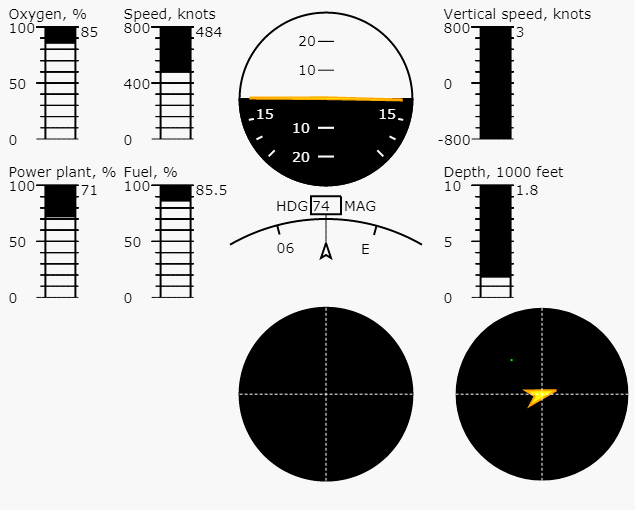
Vehicle simulators allow the player to control a variety of objects, from cars and trains to futuristic spaceships. The laws of the genre do not impose strict limits on the simulated vehicles. You can be the pilot of a machine created by humans in the future, or a machine that was created by aliens. You can move even on what is not quite correct to call the word "machine".
With such freedom in the design of devices, nothing prevents the surfing of the virtual space in any conceivable direction.
In fact, well-known simulators allow you to move in space, in the atmosphere, on the surface of the Earth and other planets, on the surface of reservoirs and in the water column, leaving only one white spot intact - the thickness of the planet.
It is difficult to determine the reasons why underground boats have not yet been implemented in simulators. This class of technology of the future, of course, is inferior in popularity to starships, teleporters and time machines. Nevertheless, subterins have left a noticeable mark in literature and cinema, starting their way in science fiction in the first half of the last century.
A detailed description of the "steel mole", including many technical details, was given by G. Adamov in his novel "Winners of the Subsoil" already in 1937, and travels on such devices also occur in relatively modern books and films . The appearance of underground boats in computer games is probably a matter of time.
Consider the appearance of the subterrine from the point of view of its imitation in simulators. The following questions seem to be key:
- ;
- ;
- ;
- .
An important feature of the subterrine is the uncertainty of the physical principles used to move an object in space. Based on examples from science fiction, you can vary the properties of the apparatus in a fairly wide range.
Writers were faced with a balance of believability and artistry, making trade-offs as they saw fit. The subterrina from Winners of the Subsoil had the right to move for months in order to maintain a plausible speed. But she could not (and did not have) a plausible combination of all technical characteristics, since this would deprive the book of the plot.
In the case of the simulator, the contradiction between realism and fascination becomes more acute than in literature and cinema. When choosing between gameplay and scientific validity of the characteristics, obviously, the first should be given priority.
Discussion of the feasibility of technical solutions and properties of the object from the standpoint of modern science has extremely low practical value. On the other hand, the lack of credibility, subjectively perceived by the player of the "physical" of what is happening, will not add quality to the simulator.
It is better to consider the mathematical model of the apparatus precisely through the prism of persuasiveness, understanding that the plausibility felt by the player has little to do with scientific correctness.
It is quite obvious that a good simulator of flying on a broomstick or carpet-flying can outperform a bad simulator of a real vehicle, which simulates reference characteristics even with good accuracy. It is hardly possible to deduce strict laws in this subjective area and substantiate specific decisions with academically verified arguments. However, decisions in physics must be made.
The following suggestions for the concept of a plausible model seem reasonable:
- The device moves in the direction of its longitudinal axis. In the absence of a developed terminology of underground fleet technology, we will use the aviation analogy: here we are talking about the equality of the values of the angle of attack and the angle of slip to zero .
- . . .
Justification of the proposed properties of the model from the standpoint of "subjective physics":
1. Movement through the earth is a complex technical problem, solved by some high-tech method, but only for one direction. It is difficult to imagine an earthworm moving "sideways" inside the ground .

2. Rotation of the apparatus without translational motion presupposes the presence of a local "flow around the soil" of its body in the transverse direction at speeds proportional to the distance from the axis of rotation. The presence of lateral movement relative to the environment contradicts paragraph 1. It seems unnatural to turn the earthworm inside the soil without longitudinal movement, except for "roll rotation" .
The preference for an elongated shape is due to the tradition of fiction and the desire to meet conservative expectations (like most existing means of movement in a liquid or gaseous medium, as well as objects moving inside solids). This form, like the concept of dynamics proposed for it, cannot be considered correct or the only possible one. A simulator of, for example, a spherical or toroidal subterrine will require its own concept.
Arcade vs Hardcore Simulator
The possibility of creating the simplest games, for example, an underground boat for Mario, is beyond doubt. It is much more interesting to estimate the limit of the attainable seriousness of the game.
The underground boat simulator will not earn the right to be considered real until the subterins themselves cease to be a fantasy. But this does not mean that the game is doomed to create only casual versions.
Without any embodiment of "steel moles" in metal, we have the ability to create the following components of the hardcore simulator gameplay:
- Full dynamics of movement of the controlled object in three-dimensional space.
- Indication of the main parameters of the device (spatial position, speed parameters, navigation information).
- System status indication (power plant, fuel system, life support system, etc.).
- ( , , . .).
- , , .
- , , .
The list presented shows that the game can be made quite deep. The fundamental difficulty exists only in visualizing the external world.
The outer space of the starship can be seen through the pilot's eyes through the porthole. The submarine can raise the periscope or be shown from a third person against the background of the surrounding underwater landscape. Rendering an underground boat that doesn't look odd has no obvious solutions and will certainly require some creative tweaks.
Playing an underground boat simulator without visualizing the outside world will have a lot to do with instrument flyingin an aircraft simulator. The image of movement in the player's mind is formed only by the data of the indication system. The simulator clearly does not win in entertainment, but it gets an interesting property: a seemingly justified rejection of demanding 3D graphics in a complex game.
Information display system
For all the novelty of the managed object, it makes sense to use some solutions from real systems as a starting point. The source of borrowing will be submarines and aircraft heavier than air.
To fully control the movement of an object in three-dimensional space, the operator needs to display the following parameters:
- heading, roll, pitch (trim);
- speed;
- vertical speed (time derivative of depth);
- depth;
- coordinates in the horizontal plane.
This display volume corresponds to the minimum information field for "piloting and navigation".
While not mandatory, the following display elements play an important role in realism:
- operating parameters of the power plant;
- the remaining fuel;
- alarm and warning signals and messages;
- the overview system is an analogue of a locator or sonar.
The group with the third priority level contains not so necessary (but rather interesting under certain conditions) indication elements:
- overload;
- microclimate parameters;
- life support system parameters;
- parameters of special equipment designed to solve mission tasks.
Implementation
A simple browser game code was written to evaluate the proposed solutions . Like any practical implementation of the simulator, it required the implementation of specific properties of the object.

Stability, handling, maneuverability, speed characteristics, efficiency of the power plant and many other parameters of this game are nothing more than one of the possible combinations of properties, taken for a sample.
Within the framework of the proposed concept, simulators can be created that radically differ from each other in the dynamics of movement.
The fantastic essence of subterins allows for a creative approach to the means of indication. For example, an artificial horizon indicator with the most daring and exotic design can harmoniously fit into the appearance of a fictional apparatus.
Simulation of aircraft and marine technology is less loyal to innovation. The pilot is unlikely to appreciate the distance from reality or traditional solutions in an airplane simulator, while terranauts have neither the first nor the second.
Challenges and opportunities
The foregoing allows us to formulate two problems of developing an underground boat simulator:
- Lack of certainty in the field of the appearance of such systems and the physics of their functioning, the lack of generally accepted guidelines.
- The difficulty of visualizing the outside world.
The potential advantages of the considered class of simulators follow from its problems:
- The developer has complete freedom in setting up the physics of the object and designing the pilot's workplace. As a basis, both the proposed above and the less conservative concept of dynamics can be taken.
- The refusal to visualize the external space, justified in the case of a subterrine, makes it possible to create a rather complex simulator without high computer requirements.